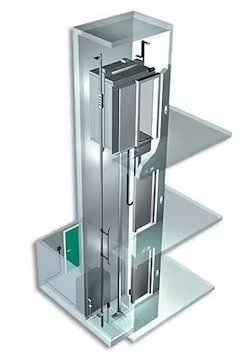Hydraulic Elevators
Hydraulic elevators are a great choice for low rise, low traffic installations due to their simple mechanical design compared to traction elevators. However, they are less energy efficient as the pump has to work against gravity to move the car upwards, resulting in energy loss when the car descends under its own weight.

Hydraulic Elevators
A Hydraulic lift system operates without the need for overhead lifting machines. Instead, these elevators rely on fluid compression to create movement. An electric motor is responsible for lifting the elevator car by pumping oil into the cylinder to move the piston.
Hydraulic elevators are regarded as the safest choice for home elevators due to their excellent user-friendliness and convenient access to the machine room located in the basement.
Special features
- Faster to install than other types of lifts.
- Hydraulic lifts are cheaper to install than other elevator types
- They occupy less space in a building, requiring almost 10% less area for the lift shaft.
- They are highly effective with heavy loads, as the hydraulic power
- provides a far greater lifting strength.
- Offer the possibility to have a configuration without a machine room.


Hydraulic lifts find widespread usage in a variety of industries and environments for the purpose of lifting heavy loads or materials. Some typical applications of hydraulic lifts are seen in:
- Automotive sector
- Construction field
- Warehousing and
- logistics operations
- Manufacturing plants
- Healthcare facilities
- Retail and commercial establishments
- Residential settings


